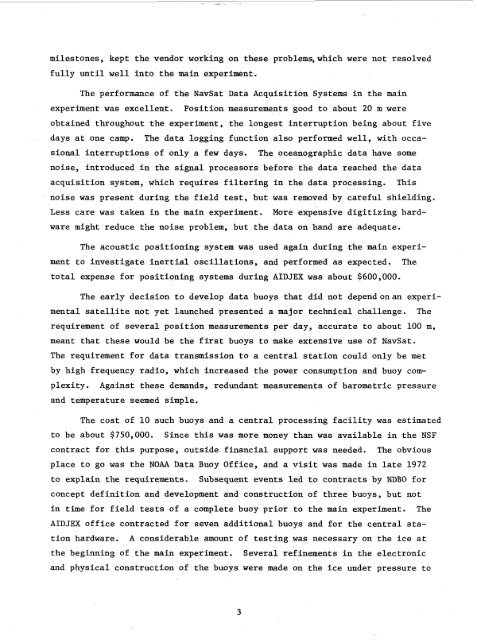AIDJEX Bulletin #40 - Polar Science Center - University of Washington
AIDJEX Bulletin #40 - Polar Science Center - University of Washington
AIDJEX Bulletin #40 - Polar Science Center - University of Washington
You also want an ePaper? Increase the reach of your titles
YUMPU automatically turns print PDFs into web optimized ePapers that Google loves.
milestones, kept the vendor working on these problems,which were not resolved<br />
fully until well into the main experiment.<br />
The performance <strong>of</strong> the NavSat Data Acquisition Systems in the main<br />
experiment was excellent. Position measurements good to about 20 m were<br />
obtained throughout the experiment, the longest interruption being about five<br />
days at one camp. The data logging function also performed well, with occasional<br />
interruptions <strong>of</strong> only a few days. The oceanographic data have some<br />
noise, introduced in the signal processors before the data reached the data<br />
acquisition system, which requires filtering in the data processing. This<br />
noise was present during the field test, but was removed by careful shielding.<br />
Less care was taken in the main experiment. More expensive digitizing hardware<br />
might reduce the noise problem, but the data on hand are adequate.<br />
The acoustic positioning system was used again during the main experiment<br />
to investigate inertial oscillations, and performed as expected. The<br />
total expense for positioning systems during <strong>AIDJEX</strong> was about $600,000.<br />
The early decision to develop data buoys that did not dependonan experimental<br />
satellite not yet launched presented a major technical challenge. The<br />
requirement <strong>of</strong> several position measurements per day, accurate to about 100 my<br />
meant that these would be the first buoys to make extensive use <strong>of</strong> NavSat.<br />
The requirement for data transmission to a central station could only be met<br />
by high frequency radio, which increased the power consumption and buoy complexity.<br />
Against these demands, redundant measurements <strong>of</strong> barometric pressure<br />
and temperature seemed simple.<br />
The cost <strong>of</strong> 10 such buoys and a central processing facility was estimated<br />
to be about $750,000. Since this was more money than was available in the NSF<br />
contract for this purpose, outside financial support was needed. The obvious<br />
place to go was the NOM Data Buoy Office, and a visit was made in late 1972<br />
to explain the requirements. Subsequent events led to contracts by NDBO for<br />
concept definition and development and construction <strong>of</strong> three buoys, but not<br />
in time for field tests <strong>of</strong> a complete buoy prior to the main experiment. The<br />
<strong>AIDJEX</strong> <strong>of</strong>fice contracted for seven additional buoys and for the central station<br />
hardware. A considerable amount <strong>of</strong> testing was necessary on the ice at<br />
the beginning <strong>of</strong> the main experiment. Several refinements in the electronic<br />
and physical construction <strong>of</strong> the buoys were made on the ice under pressure to<br />
3








